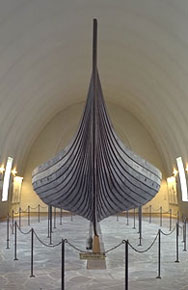

The Gokstad ship was found
in a large burial mound at the Gokstad farm in Sandar, Vestfold
in 1880.
The ship had been built around 890 A.D. and later used in the
ship burial of an important chieftain who died in or around 900
A.D.
The dead man, a powerfully built man in his 60's, lay in his bed
in a timber burial chamber (displayed in the Tune wing of the
Museum).
He was buried with his grave furnishings which consisted of three
small boats, a tent, a sledge and riding equipment.
The preservation conditions in the Gokstad mound were as favourable
as at Oseberg.
The mound had been plundered in ancient times, however, and any
valuables of silver and gold which may have been deposited as
burial goods, were removed.
Weapons, which are usually part of a Norwegian man's burial furnishings
during Viking times, were also missing.
These may also have been removed by grave robbers.
The Gokstad ship, built of oak, is 24 meters long , 5 meters wide
and is the largest of the three ships in the museum.
It could accomodate 32 oarsmen and was much more sturdily built
than the Oseberg ship.
The keel and mast step are sturdier and the ship's sides are higher,
with two strakes above the oar holes.
The oar holes could be hatched down when the ship was under sail.
Using a square sail of 110 sq. m., the ship could reach speeds
of over 12 knots.
The rudder could be raised when the ship was sailing in shallow
water.
64 wooden shields (painted alternately black and yellow) were
found during the excavations.
These had been fastened on the outside of the ship's railing.
One of the shields is displayed on a wall in the artifact collection
wing.
The Gokstad ship, although not as luxuriously outfitted as the
Oseberg ship, was by far the more seaworthy of the two.
Just how seaworthy it had been, was demonstrated when a copy of
the Gokstad ship sailed the Atlantic from Bergen to the World's
Fair in Chicago in 1893.
The burial chamber, two of the small boats and two tent verge
boards from the Gokstad burial, are displayed in the Tune wing.
This burial chamber is the oldest example of the lafting technique
known in Norway.
Large sections of the roof were hacked away by the grave robbers.
The small boats resemble boats still used in western and northern
Norway, and testify to a long tradition of Norwegian boat building.
Some of the other objects from the Gokstad burial are to be found
in the artifact collection wing, such as bedposts with animal
head ornamentation and fragments of a sledge.
A hunter`s rucksack and a gaming board are indications of how
the upper class spent their leisure time.
Horses and dogs were also part of the burial gifts.
The harness and bridal mounts are of the finest quality.
The most unusual item is the remains of a peacock, an exotic element
in Norwegian Viking times.
Fragments of gold thread woven into textiles found in the Gokstad
burial are displayed in the textile room.